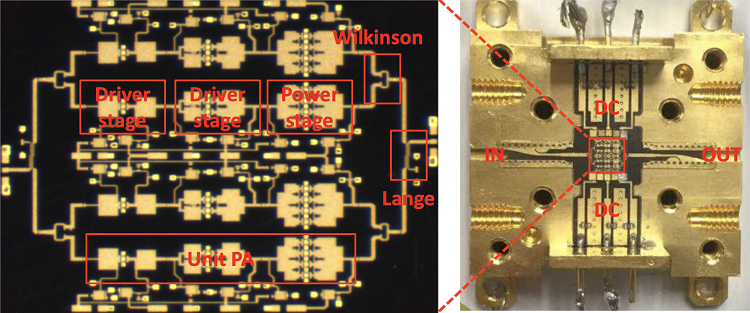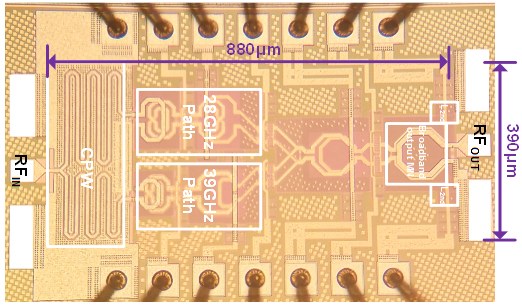Tianjin University School of Microelectronics publishes a paper at ISSCC 2020
Recently, School of Microelectronics at Tianjin University publishes a paper entitled “A W-Band Power Amplifier with Distributed Common-Source GaN HEMT and 4-Way Wilkinson-Lange Combiner Achieving 6W Output Power and 18% PAE at 95GHz” at IEEE International Solid-State Circuits Conference 2020 (ISSCC 2020). This is the first time that Tianjin University has published a paper in ISSCC – the worldwide flagship conference on integrated circuit design. The work is collaborated between Tianjin University, and Science and Technology on Monolithic Integrated Circuits and Modules Laboratory, Nanjing, China. Prof. Keping Wang is the sole corresponding author of the paper, and he introduced this work in ISSCC 2020 as an oral presentation. Prof. Wang is currently the member of Microelectronic Team of Wireless Communication and Sensor Technology.
Meanwhile, Mr. Zonglin Ma presented his paper entitled “A Dual-Band Three-Mode Frequency-Reconfigurable Power Amplifier for 5G Carrier Aggregation” at ISSCC 2020 Student Research Preview (SRP) session. Mr. Zonglin Ma is a Ph.D candidate that supervised by Prof. Kaixue Ma, the leader of Microelectronic Team of Wireless Communication and Sensor Technology.


Prof. Wang demonstrated a fully integrated and packaged W-band GaN power amplifier that achieves a peak output power of 6W and 18% PAE at the frequency of 95GHz by using the following techniques: first, a distributed common-source HEMT is proposed by dividing it into the scalable and non-scalable parts. Second, a 4-way Wilkinson-Lange combiner with low impedance transformation ratio is designed to minimize the bandwidth and output power reduction. The reported W-band power amplifier can play an important role in Gb/s data-rates wireless communication, imaging and radar applications.

Figure.1 Die micrograph and package of W-band power amplifier
Mr. Zonglin Ma's paper reports a dual-band, three-mode frequency-reconfigurable power amplifier (FRPA) based on a 55-nm CMOS process for millimeter-wave 5G communication. Based on the proposed novel amplifier prototype, the FRPA operates in three modes: single-band mode at 28 GHz, single-band mode at 39 GHz, and concurrent 28 GHz and 39 GHz dual-band mode. It comprehensively covers domestic and international 5G hotspot research frequency bands, and provides technical support for the implementation of millimeter-wave 5G dual-band communication transceiver. Meanwhile, the FRPA conforms to the development trends and requirements of commercial mobile communication terminals at low cost, small size, and low power consumption.

Figure.2 Die micrograph dual-band, three-mode frequency-reconfigurable power amplifier
ISSCC - the worldwide flagship conference sponsored by IEEE SSCS – begun in 1953. It is a global academic exchange forum for engineers and researchers to demonstrate the latest research results of solid-state circuits and system-on-chip (SoC). For decades, it has represented the highest international academic level in the field of integrated circuit and enjoyed the reputation of "Chip Olympics".
Tianjin Key Laboratory of Imaging and Sensing Microelectronic Technology has 10 full/associate professors, including Academician of the Canadian Academy of Engineering, IEEE Fellow, National "Outstanding Youth" scholar, Yangtze River Scholar, National Distinguished Expert. The Lab is financially supported by “National Science and Technology Major Project of the Ministry of Science and Technology of China”, “National Key R&D Program of China”, and “The Key Program of National Natural Science Foundation of China”, and et al. The team has made a number of research results in integrated circuits and systems. In terms of simulation software, Neuro Modeler, a microwave optimization simulation software with completely independent intellectual property rights, has been developed. The team has a world-class scientific research and testing platform that integrates microwave terahertz microelectronic system design, device parameter extraction, and communication integrated system reliability testing. The operational frequency of equipment can continuously cover up to 1140 GHz. The team also developed a complete heterogeneous integrated microsystem processing platform.